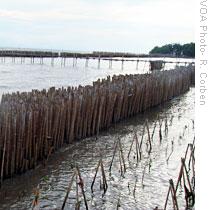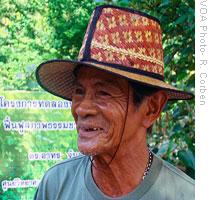Bangkok
20 October 2009
 |
| Bang Khun Thien's Bamboo sea wall serves as protection from the sea, Gulf of Thailand, Thailand, 20 Oct 2009 |
A long boat wends its way along an estuary near Bang Khun Thien near Bangkok on the Gulf of Thailand.
Telephone poles stand in the water, a reminder that this was once dry land, with streets and homes.
Economic growth vs. the environment
Twenty years ago as Thailand pursued economic growth, mangrove forests along the coast were torn up. The wood was made into charcoal and the land was used for shrimp farms and other developments.
Krongsak Lerknagm is chairman of the Klong Pittayalong Community, a conservation group that focuses on mangrove restoration and shore protection.
Krongsak says an area of 2,735 rai - almost 450 hectares - was once covered by mangroves. As a boy he would make the long journey to the sea shore through the forests.
In Bang Khun Thien, families, businesses and government offices have been forced to higher ground over the past 20 years.
Mangrove trees grow in shallow coastal and estuarial waters in the tropics - in Southeast Asia, Africa and the Americas. They provide breeding grounds for many marine species, and help prevent soil erosion by protecting land from strong waves and reducing flood damage.
But in many countries, they have been cut down to make way for fish farms, resorts or other developments. Environmentalists and coastal dwellers around the world say that has led to erosion, pushing the sea farther inland. There is concern that global warming will raise sea levels, worsening the loss of land caused by cutting down mangroves.
Turning back the clock
 |
| Mangrove sapling planting in Bang Khun Thein, Thailand, 20 Oct 2009 |
Janaka de Silva is a program coordinator for the conservation union.
"The coastal erosion problem here is a function of many factors and climate change is really something that is going to most likely make the situation even worse," he said.
Mangroves cover 240,000 hectares in Thailand. But the World Bank warns that the coastline is eroding at a rate of 1-5 meters a year, at a cost of $150 million.
Near Bang Khun Thien, at the Mahachai Mangrove Center, mangrove saplings are planted and protected from the waves with long thin walls of bamboo poles pressed into the mud.
 |
| Narin Boonruam, leader of the Kok Klam Conservation Group in Thailand, 20 Oct 2009 |
Narin says the work is showing results, with increased bird populations and sightings of the rare Irrawaddy dolphin. But he says more is needed.
The government, he says, should pay more attention to this work to help protect the coastal resources and be more supportive of the communities.
The government is involved. Pinsak Surasvadi, a director, with Thailand's Department of Marine and Coastal Resources says that by working with coastal communities it has stabilized the amount of mangrove forests.
"It's going to be better and better. I think the most important thing is the community. They know the importance of the mangrove," he said. "The community here they do not only regenerate the mangrove they also [help] on the other problem - coastal erosion," he added.
 |
| A regenerated mangrove forest in Prachuab KhiriKhan province, Thailand, 20 Oct 2009 |
Mobilizing the community
Nearly 300 kilometers south of Bank Khun Thien, in Prachuab Khirikhan province, more than a decade of work has restored 90 hectares of mangroves destroyed to build shrimp farms.
Financial support for the program came from the state-owned Petroleum Authority of Thailand. Pichapong Pokapun, a project spokesman, says the mangrove restoration is part of a wider program to support reforestation throughout Thailand.
Pichapong says community involvement is essential if the program is to succeed.
"This land is the mangrove and has value so we give it importance. At first the aim we would like to increase the natural resource base of this area," he said. "Then the people in this community would like to participate in the project too. So we succeed because we have the community join our project," he said.
Conservationists say the replanting programs are becoming more urgent, because mangroves are needed to help hold back rising sea levels as the climate warms. Pinsak, from the Department of Marine and Coastal Resources, says in the past, human action led to ruined mangroves and greater erosion, but in the future, global warming will worsen the problem.